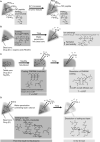pH- and ion-sensitive polymers for drug delivery
- PMID: 23930949
- PMCID: PMC3912992
- DOI: 10.1517/17425247.2013.821978
pH- and ion-sensitive polymers for drug delivery
Abstract
Introduction: Drug delivery systems (DDSs) are important for effective, safe, and convenient administration of drugs. pH- and ion-responsive polymers have been widely employed in DDS for site-specific drug release due to their abilities to exploit specific pH- or ion-gradients in the human body.
Areas covered: Having pH-sensitivity, cationic polymers can mask the taste of drugs and release drugs in the stomach by responding to gastric low pH. Anionic polymers responsive to intestinal high pH are used for preventing gastric degradation of drug, colon drug delivery and achieving high bioavailability of weak basic drugs. Tumor-targeted DDSs have been developed based on polymers with imidazole groups or poly(β-amino ester) responsive to tumoral low pH. Polymers with pH-sensitive chemical linkages, such as hydrazone, acetal, ortho ester and vinyl ester, pH-sensitive cell-penetrating peptides and cationic polymers undergoing pH-dependent protonation have been studied to utilize the pH gradient along the endocytic pathway for intracellular drug delivery. As ion-sensitive polymers, ion-exchange resins are frequently used for taste-masking, counterion-responsive drug release and sustained drug release. Polymers responding to ions in the saliva and gastrointestinal fluids are also used for controlled drug release in oral drug formulations.
Expert opinion: Stimuli-responsive DDSs are important for achieving site-specific and controlled drug release; however, intraindividual, interindividual and intercellular variations of pH should be considered when designing DDSs or drug products. Combination of polymers and other components, and deeper understanding of human physiology are important for development of pH- and ion-sensitive polymeric DDS products for patients.
Figures


Similar articles
-
Hydrazone linkages in pH responsive drug delivery systems.Eur J Pharm Sci. 2017 Mar 1;99:45-65. doi: 10.1016/j.ejps.2016.12.011. Epub 2016 Dec 12. Eur J Pharm Sci. 2017. PMID: 27979586 Review.
-
Ion-Responsive Drug Delivery Systems.Curr Drug Targets. 2018 Feb 8;19(3):225-238. doi: 10.2174/1389450117666160527142138. Curr Drug Targets. 2018. PMID: 27231110 Review.
-
In situ gelling polymers in ocular drug delivery systems: a review.Crit Rev Ther Drug Carrier Syst. 2009;26(1):85-118. doi: 10.1615/critrevtherdrugcarriersyst.v26.i1.30. Crit Rev Ther Drug Carrier Syst. 2009. PMID: 19496748 Review.
-
Eudragit: a technology evaluation.Expert Opin Drug Deliv. 2013 Jan;10(1):131-49. doi: 10.1517/17425247.2013.736962. Epub 2012 Oct 26. Expert Opin Drug Deliv. 2013. PMID: 23102011 Review.
-
Advances in oral controlled drug delivery: the role of drug-polymer and interpolymer non-covalent interactions.Expert Opin Drug Deliv. 2015 Mar;12(3):441-53. doi: 10.1517/17425247.2015.966685. Epub 2014 Sep 30. Expert Opin Drug Deliv. 2015. PMID: 25267345 Review.
Cited by
-
Development, Optimization and Characterization of Eudraguard®-based Microparticles for Colon Delivery.Pharmaceuticals (Basel). 2020 Jun 24;13(6):131. doi: 10.3390/ph13060131. Pharmaceuticals (Basel). 2020. PMID: 32599861 Free PMC article.
-
"Enhancing Oral Drug Absorption: Overcoming Physiological and Pharmaceutical Barriers for Improved Bioavailability".AAPS PharmSciTech. 2024 Oct 1;25(7):228. doi: 10.1208/s12249-024-02940-5. AAPS PharmSciTech. 2024. PMID: 39354282 Review.
-
Dissolving and Swelling Hydrogel-Based Microneedles: An Overview of Their Materials, Fabrication, Characterization Methods, and Challenges.Gels. 2023 Oct 7;9(10):806. doi: 10.3390/gels9100806. Gels. 2023. PMID: 37888379 Free PMC article. Review.
-
Force-Triggered Self-Destructive Hydrogels.Adv Mater. 2023 Dec;35(52):e2305544. doi: 10.1002/adma.202305544. Epub 2023 Nov 20. Adv Mater. 2023. PMID: 37724392 Free PMC article.
-
Experiments and modeling of controlled release behavior of commercial and model polymer-drug formulations using dialysis membrane method.Drug Deliv Transl Res. 2020 Apr;10(2):515-528. doi: 10.1007/s13346-019-00696-1. Drug Deliv Transl Res. 2020. PMID: 31828534
References
-
- Alam MA, Ali R, Al-Jenoobi FI, et al. Solid dispersions: a strategy for poorly aqueous soluble drugs and technology updates. Expert Opin Drug Deliv. 2012;9:1419–40. - PubMed
-
- Alani AW, Rao DA, Seidel R, et al. The effect of novel surfactants and Solutol HS 15 on paclitaxel aqueous solubility and permeability across a Caco-2 monolayer. J Pharm Sci. 2010;99:3473–85. - PubMed
-
- Yoshida T, Kurimoto I, Yoshihara K, et al. Aminoalkyl methacrylate copolymers for improving the solubility of tacrolimus I: evaluation of solid dispersion formulations. Int J Pharm. 2012;428:18–24. - PubMed
-
- Sawada T, Kondo H, Nakashima H, et al. Time-release compression-coated core tablet containing nifedipine for chronopharmacotherapy. Int J Pharm. 2004;280:103–11. - PubMed
-
- Katsuma M, Watanabe S, Kawai H, et al. Effects of absorption promoters on insulin absorption through colon-targeted delivery. Int J Pharm. 2006;307:156–62. - PubMed
Publication types
MeSH terms
Substances
Grants and funding
LinkOut - more resources
Full Text Sources
Other Literature Sources
Research Materials
